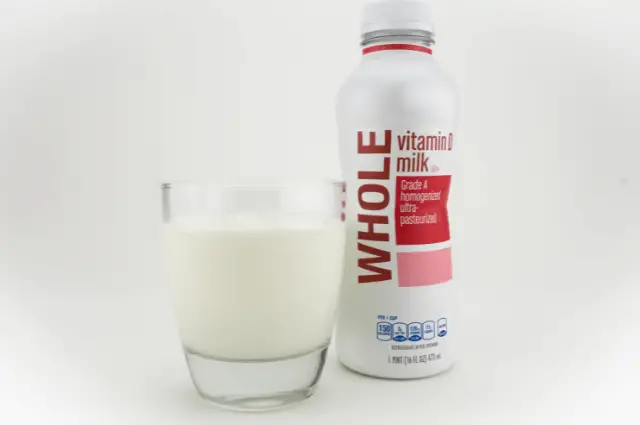Most moms want to know how to warm whole milk for babies. Pediatricians recommend that toddlers be given whole full-fat milk when transitioning them from breast milk to regular cow milk. This transition to whole milk should take place at 12 months and not before because whole milk does not have appropriate nutritional make-up for babies, and it also contains specific proteins and a higher mineral content that may be difficult for a child below 1 to digest.
Hey! By the way… any links on this page that lead to products on Amazon are affiliate links and I earn a commission if you make a purchase. Thanks in advance – I really appreciate it! .
Mothers should give whole milk, not reduced-fat milk, to children between 1-2 years as at this age, they require extra fat in their diet to support peak brain development, says the American Academy of Pediatricians. You have to make this transition gradually and consider the temperature of the milk your baby is used to. This is because most infants are used to warm breast milk, and they might be put off by cold whole milk.
This article is just right for you mothers as we would be telling you how to warm whole milk for babies in ways that are harmless.
Can You Use Your Microwave to Warm Whole Milk for Your Baby?
Though warming milk has no nutritional value, most children prefer lukewarm milk hence the necessity. One way mothers warm their babies’ milk is by microwaving because it is fast and less stressful.
Many reservations regarding the use of microwaves for heating milk have risen, with some claiming that bags and bottles are at risk of exploding and the milk might lose some of its essential vitamins. So, some groups of people say it is very unsafe.
However, another group of people says there is nothing wrong with microwaving milk if done gradually and properly. When you rush the process, it poses a problem. To heat milk using a microwave:
- Pour the milk into a microwave-safe container. If you plan to make something else in that same container, ensure you leave space at the top.
- Set the microwave to medium-high heat, then program it for 15 seconds.
- Remove the container carefully from the oven and stir the milk carefully.
- Reset the microwave to medium-high heat for another 15 seconds, remove, then stir it again.
- Continue this process, stopping to stir at intervals of 15 seconds.
- Your milk is ready when steam rises from it.
250 mls (one cup) of milk should be ready in about 45-go seconds.
Note that if you do not take proper care in microwaving milk, it would heat unevenly and result in scorching at the top. The microwaved milk can also develop hot spots that can burn the baby’s mouth; to prevent this, allow the milk to rest for a few minutes, then drip test it to ensure the temperature is safe for the baby.
How Can I Warm Refrigerated Milk?
When breast milk is refrigerated, the fat tends to separate from the milk in the bottle. So, warming the breast milk can mix the milk back to its original evenness more easily. To warm refrigerated milk,
- Take the milk from the fridge, then set it aside.
- Use a kettle or microwave to heat water; pour the hot water into a bowl.
- Put a bottle or sealed bag of milk into the bowl of warm water. Ensure the milk is in a sealed container while warming.
- Let the milk remain in the warm water for about 1-2 minutes until it reaches your desired temperature.
- Pour breast milk into a bottle, and if already in a bottle, screw on the bottle nipple with clean hands.
- Swirl the milk gently to mix in the fat if it was separated.
You can also warm the milk by holding the bottle or a sealed bag under very hot running water from the tap. This is, however, dangerous because it could burn your hand.
Before giving your baby the milk, check its temperature by pouring a little on your wrist but never put your finger into the milk to prevent contamination. Also, do not leave the warm milk out at room temperature, and if the baby does not finish it, throw it out.
Is Warm Milk Better Than Cold Milk?
There have been many debates over which milk is better, cold milk or hot milk? It should not be, though, as both cold and hot milk is equally healthy and nutritional. Most babies prefer warm milk, but some do not mind cold milk. However, before deciding which to give your baby, ensure you consider the weather condition and time of the day.
Benefits of Cold Milk
You might want to consider giving your baby cold milk because it makes traveling easier and reduces the risks of overheating. Here are some additional benefits of cold milk.
- It reduces stomach discomfort; nevertheless, it can lead to pain and difficulty in sleeping when taken at night.
- It fights hunger pangs and fills up faster.
- Cold milk is known to be good for the skin as it provides the skin with necessary proteins.
- It contains electrolytes that aid body hydration.
Benefits of Warm Milk
- Milk contains tryptophan, an amino acid known to induce sleep which is activated when milk is warm.
- Warm milk is said to reduce stress.
- When taken together with honey, warm milk is said to have an anti-bacterial effect and is especially effective as a cough remedy.
- It warms the body during winter.
Does Warm Milk Formula Help with Gas?
Studies show that warm formula plays no role in preventing gas though it has impressive health benefits. However, heating milk can cause gas for babies; this is because shaking of milk while heating can increase the air bubbles in the milk resulting in gas if swallowed by your baby.
So, ensure you are careful while heating your baby’s milk by ensuring the bottle or container is air-tight.
Final Thoughts
Above are suggestions on how to warm whole milk for babies. Before carrying out any step concerning your child, ensure you contact your pediatrician. This will help you know the kind of milk you can give your child, especially in allergic reactions. Also, take extra care when storing, heating, or giving your child milk.
If you decide to warm your baby’s milk using a microwave, please follow the steps above carefully to ensure the safety of your precious child.

